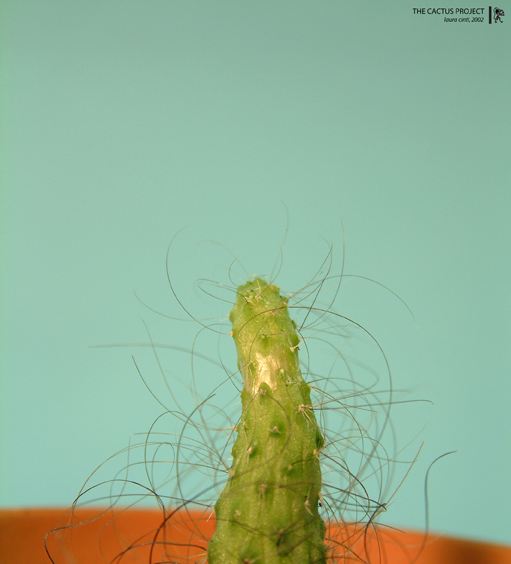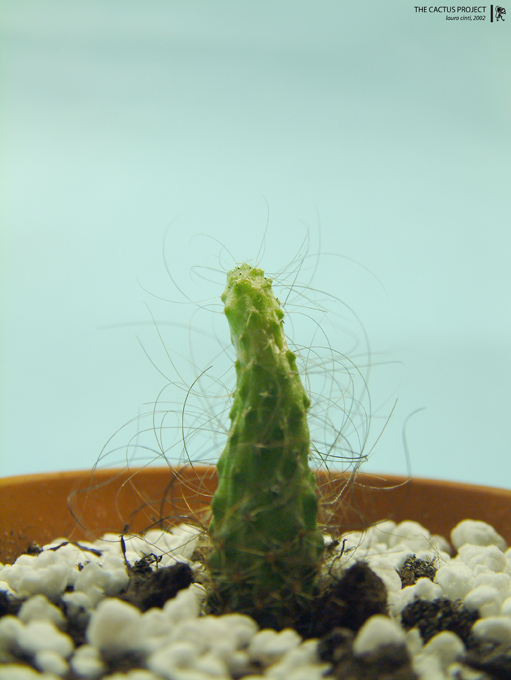
Laura Cinti : The Cactus Project
The Cactus Project (2002- ) is a collaborative bio-art project resulting in cactis expressing human hair. As a transgenic work, it entails the transfer of genetic material from one specie to another, in this case, the insertion of keratin genes into the cactus genome.
The work has been exhibited in the UK, and the remaining cactis are currently being considered for further exhibitions or possible transplantations into the wild. Laura Cintis next art venture c-lab is in collaboration with Howard Boland. She will continue to work with bio-art.
***

1. You've created a transgenic vegetal of particular kind: cactus with human hairs. How did you proceed and what are the reasons of your choice?
The cactus project began in 2001. Our logistical challenge was having the keratin gene expressed in cactus cells morphologically similar to hair and for the cactus to produce it externally (although it would have been just as interesting for me had it been produced internally). Initially our interest was experimenting with and producing transgenic plants. The choice of working with cactis came down to their fleshy construct often appearing monolithic and at the same time innocent - protected by growing spines. Hair, on the other hand, is a reproductive sign, for it is a sign of our body changing, becoming sexual. The transformation process produced a fascinating semantic orgy, turning genetic engineering inside-out, whose asexual sterile process had been reversed by the transgenic cactus remaining sexual (an organic dildo - growing).
2. Your work has been diversely appreciated by the public: what has been
the spectrum of reactions and how do you explain them (positive or negative)?
The reactions have been extremely varied. I have received numerous requests
to obtain cuttings, seedlings and seeds of the transgenic cactus and immense
interest in its flowering and fertility potential. Some find it highly irresponsible,
immoral, provoking, and ethically disturbing and even it being a hoax. Some
feel that I am short-sighted and trying to shock.
Others have found the transgenic cactus a challenging and exciting work dealing
with complex issues around biotechnology in unprecedented manner. I have had
supportive feedback in continuing working with bio-art and related issues.
During
exhibitions, the responses were also very varied with some walking pass without
even noticing the work whilst others were paralytically captivated upon discovering
it. It was brilliant to actually observe the reactions relating it to how these
cultural issues concern us.
I generally find that scientists and cacti-specialists are more intrigued with
these kinds of projects than most artists. Also in the manner of the theoretical,
semantical, critical issues and openings this kind of project generates.
On the issue of morality, it is of course something most artists working with genetics face, perhaps more than scientists who are guarded by their serving of society and research. I think this project confronts the issue of morality in itself. What is moral in the 21st century? The aim of the project has not been intended to provoke but rather obscure through subtleties in the cultural impact of genetics. We wanted the project to manifest itself and live within our culture as a natural part of it. Morality, here, is not an obstacle for me in the creating of valid art.
In terms of art, the question of morality operates on different regulations to science, and this is perhaps arts own shield when facing immorality.
3. Can we hope an exhibition of your cactus in France? If not, where is it exposed?
The transgenic cactis were shown in exhibitions in the UK. It would be interesting
to exhibit one of the cactis in France, at this point in time we are planning
to go in one of two directions, either to further exhibit the transgenic cactis
or to transplant them in the wild.

4. After the haired cactus, what will be your next transgenic creation?
I
will continue working with transgenics and cactis. One pathway I am investigating
with fellow collaborator, Howard Boland, is working with semi-living entities,
combining neural networks and viruses.
5. More generally, do you think that the creation of new kinds of life by humans is a amoral sin of our hubris or a natural fruit of our creativity?
One
of the cybernetic paradigms tells us that we have evolved the ability to evolve
(second level emergence). I feel that what is interesting about art in the realm
of genetics and biotechnology is that it offers alternative investigations into
what can be created and communicated.
I think we are beyond the point of what is natural and what is not.
6.
Is there a limit (and which one) to the artistic creation with living materials?
Yes,
I do believe there should be regulations when it comes to suffering and pain.
It is a question often discussed in terms of science, to what extent these limits
should be ignored in the pursuit of knowledge. There are many artworks that
deal with our power to take life such as goldfish in a blender, however bio-art
is more concerned with the appreciation of a greater diversity and with what
can be considered life.
Interview by Esther Quintero